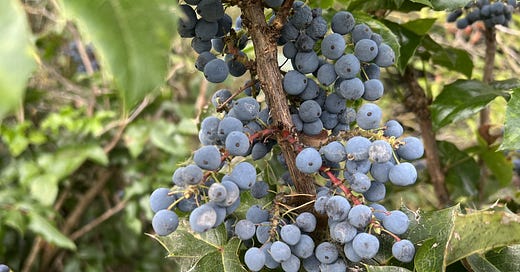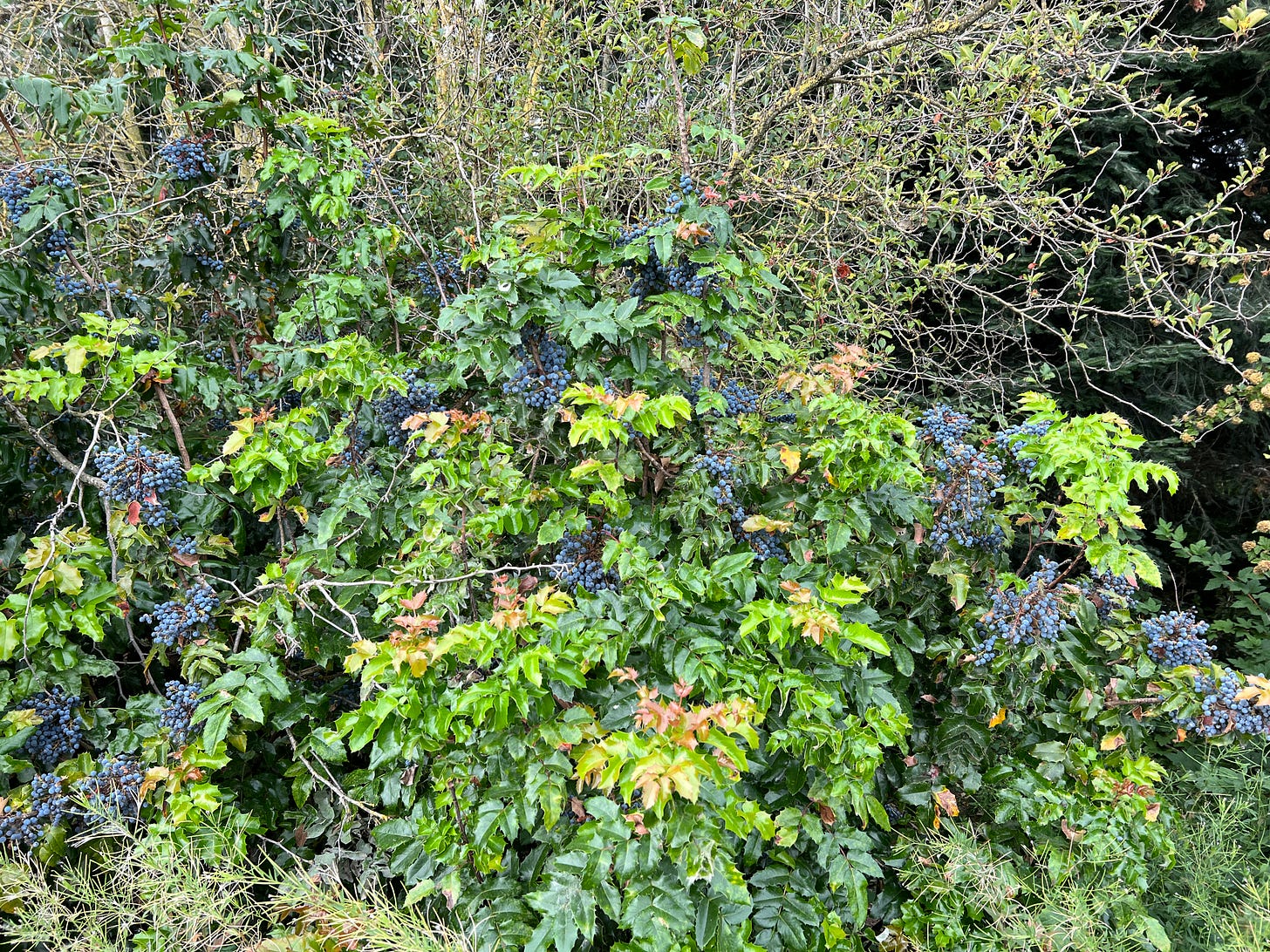Oregon grapes are everywhere you walk in Portland, from late spring to mid-August. The sidewalks in front of Portland State University downtown, and the Amazon Distribution Center at the northernmost tip of St. Johns. The trails through the Smith and Bybee Wilderness. The parking lots of most of the New Seasons markets where I shop. With their holly-like leaves, which stay dark green even in September, and their clusters of dark purple berries, Oregon grapes seem to be landscape planners' favorite native ornamental.
There's something pejorative about the word ornamental. A trophy boyfriend. A frilly bow taped onto a gift box. Something made to look at and then discard. Each time I spot Oregon grapes along my walks, the berries' deep color issues an invitation, the spiky leaves, a warning. What puzzles me the most: Birds and squirrels don't sweep the bushes clean of ripe fruit.
When I flip through my books on Pacific Northwest native foodways, they suggest that Oregon grapes have never held a universal appeal, at least culinarily speaking, for the people who have lived amid them since time began. Some tribes have used the roots and berries as medicine, others for dyeing basket materials. According to Erna Gunther's Ethnobotany of Western Washington, Samish, Swinomish, Snohomish, and Lummi people would eat the berries fresh, while the Makah called the Oregon grape kluksitlkobupt, "raven plant," fit only for birds.
Our landscape designer has marked a few shady corners where we're meant to plant Mahonia aquifolium as part of the edible meadow that's replacing our front lawn. And the foraging websites, forums, and books I consult are all agreed: Oregon grape makes great jelly.
"Makes great jelly" is the "but he's such a nice guy" of the foraging world. A few of the things on my list to glean or forage in order to make great jelly: elderberry, crabapple, fireweed, Queen Anne's lace flowers—not to be confused with poison hemlock, which looks awfully similar. A few of the things from which I have already made jelly that has not turned out to be great jelly: forsythia flowers, medlars. (Though, when it comes to the latter, I suspect my lack of jelly-making prowess was at fault.)
Last month, I biked up to the Columbia Slough, which cuts through north and northeast Portland, with a pair of gardening gloves and a plastic bag to gather Oregon grapes before they shriveled away, heartbroken by our lack of interest. The tiny berries were so plentiful that I pulled them off by the fistful, harvesting four cups in a quarter-hour. I brought them home, washed them a few times. Following the instructions on one website, I boiled and mashed them with a little water into a thick purple syrup.
The steam flowing out of the pot had an unpleasantly earthy overtone, and it didn't disappear when I dipped a spoon into the tart syrup to taste. I've still never eaten bear, but the unsweetened Oregon grape syrup tasted what I imagine bear tastes like: feral and musky, the olfactory equivalent of a growl emerging from the trees. I strained the syrup and stashed it in the back of the fridge until I came up with a better idea. Then blackberry season hit its peak.
If the Oregon grape is beloved as an ornamental because it seems to bow to human will, rarely escaping the sidewalks and dividers where it's planted, the Himalayan blackberry is the raccoon of Northwest fruit. Through a combination of menace and fecundity, it has taken over huge swaths of the landscape here. Its vines swell into 8-foot-high, thorny thickets in parks and along roadsides, defying Roundup and goats. One blackberry vine has been attempting to colonize our side lawn for years, and several times a year I put on my thickest leather gloves and snip the tendrils down to the ground, scratching up my arms in the process. Neither of us has given up.
Unlike with some invasive weeds, we know just who to blame for the Himalayan blackberry invasion: late 19th-century plant breeder Luther Burbank. The Californian scientist, who also introduced the Shasta daisy and the plumcot, apparently crossed an Armenian blackberry with another species to produce a "thornless" blackberry that West Coast residents enthusiastically planted, only to discover that the thorns quickly returned, and how.
Himalayan blackberries, when you get them at their absolute ripest, are kind of wonderful, as juicy and rich as Oregon grapes look like they should be. When I lived in Seattle, at least once a summer I would head down to Magnuson Park or along the trails and gather enough to make the seediest, crunchiest, sweetest jam.
A friend and I took a blackberry walk along some of the unpaved alleyways in our neighborhood, where a woman invited us to take all the berries we wanted from her high blackberry hedge, which she used as a vegetal barbed-wire fence. Then we wandered back to the dog park, where the fennel forest flows around hippopotamus-sized blackberry stands. I picked another few cups of berries over the course of a sunny, fennel-scented hour, leaving with wrists cross-hatched with shallow scratches and purple splats across my pants and shoes.
At home, I mashed and boiled the blackberries, strained out the seeds, and then combined the juice with an equal amount of the Oregon grape juice. Then I made jelly. The grapes' acidity cut through the deep sugary blackberries, and just as I hoped, the blackberries erased the gamier notes of the grapes.
The jelly tastes more like jam, dense and opaque, but it felt like my first easy win of this project: rescuing the unloved, the overabundant, the ignored. A victory of good taste (mine, duh) over the fruits' natural deficits. I've made PB&Js with it and begun giving tiny jars, labeled "Wild Jelly," away to friends. Next year, I may leave the Oregon grapes to the ravens. Or maybe not. Sometimes abundance, mixed with a little danger, is too taunting to pass up.








I love these pieces, Jonathan. YOU'RE a gift!
Ha! That took a lot of guts to eat those Oregon grapes. I'm so grateful you did! I've never been brave enough to do so.